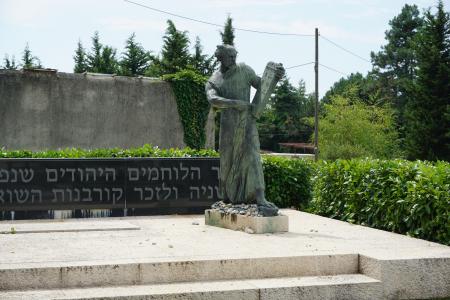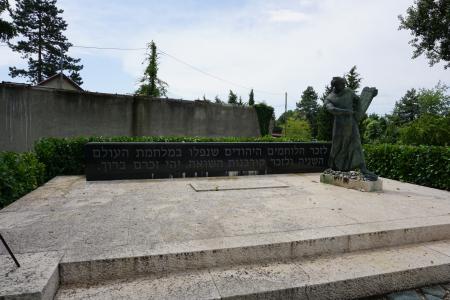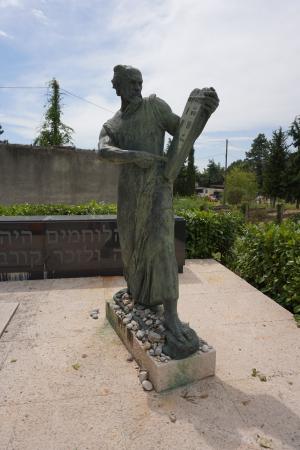Obj. ID: 40125
Memorials Holocaust memorial in the Jewish section of the Mirogoj cemetery in Zagreb, Croatia
To the main object: Jewish section of the Mirogoj cemetery in Zagreb, Croatia

Memorial Name
No official name
Who is commemorated?
Victims of the Shoah and the Jewish fighters in the War of National Liberation
Description:
The memorial is situated in the southern part of the Jewish section of the Mirogoj cemetery.
It is a raised platform made of white stone, on which are situated the three main elements of the memorial: a statue of Moses with the Tablets of the Law, a black marble slab with Hebrew inscription, and a plaque in the floor with long Serbo-Croatian inscription.
TThe statue of Moses was taken from the grave of the Glück family. The Tablets of the Law he is carrying represent the commandments using Roman numerals, except for two which are written in Croatian: “thou shalt not kill” and “thou shalt not steal.” A special plaque was installed on the grave of the Glück family where the statue originally stood (see here and here).
Inscriptions
Serbo-Croatian:
U spomen na žrtve Šoa i židovske
borce u narodno-oslobodilackom
ratu u ovoj grobnici sahranjen
su posmrtni ostaci neznanie
židovskih žrtava preneseni iz
logora Jasenovac – Gradiska koji
simboliziraju sve žrtve cija su imena
pohranjena u zakopanoj urni
Translation: In memory of the victims of the Shoah and the Jewish fighters in the War of National Liberation, the remains of unknown Jewish victims brought from the Jasenovac - Gradiska camp are buried in this tomb, symbolizing all the victims whose names are stored in the buried urn.
Hebrew:
לזכר הלוחמים היהודים שנפלו במלחמת העולם
השניה ולזכר קורבנות השואה. יהי זכרם ברוך
Translation: In memory of Jewish soldiers fallen in World War II and in memory of victims of the Holocaust. May their memory be blessed.
Commissioned by
The Jewish Community of Zagreb and the Federation of Jewish Communities of Yugoslavia
sub-set tree:
Black wall: length 585 cm, height 77 cm, height of the plate with an inscription - 62 cm.
Statue: height 215 cm, width 111 cm
Plaque in the ground: 180 x 73 cm
Bronze statue of Moses, originally placed on the Glück family monument in 1932 (see IDs 365329, 365330, 365331), now serves as the cemetery’s Holocaust memorial.
The inauguration of this monument was part of a larger action by the Federation of Jewish Communities of Yugoslavia to unveil central monuments to the victims in Sarajevo, Belgrade, Zagreb, Novi Sad, and Đakovo in September and October 1952.
Emil Kerenji wrote about the messages that these monuments conveyed:
The dedication ceremonies and the monuments themselves reflected the dual goals of the [Jewish] Federation—the commemoration of specifically Jewish victims of the war in the context of confirmation of the officially revered legacies of the “struggle for national liberation” (narodnooslobodilačka borba) and “brotherhood and unity” (bratstvojedinstvo). Monuments were thus meant to commemorate both the “Jewish victims of Fascism” and “Jewish fallen fighters,” in accordance with the ritual mode of commemoration of World War II that was being established in Yugoslavia at the time [...].
The monuments did, however, feature Jewish motifs that were immediately recognizable to Jews, and that invoked cultural connotations that were of an entirely different order than those provided by the discourses of “victims of Fascism” and “fallen fighters.” [...] The monuments thus simultaneously conveyed two different cultural contexts—one compatible with the reigning ideological mode of commemoration of World War II, fully and literally translatable into Hebrew, the language of the new Jewish culture; and one more elusive, and accessible only to those familiar with Jewish culture and tradition.
One important caveat regarding the monuments in Yugoslavia ... is that they were located in the Jewish cemeteries. They were thus removed from the full view of the general Yugoslav public. They were located at the periphery. Monuments to general, unnamed “victims of Fascism” and “fallen fighters” were being built across Yugoslavia, in central locations in cities, towns, and villages. Monuments to Jewish victims, however, because they commemorated a specific ethnic group, could not vie for those locations. But since their primary importance for the Jewish communities in Yugoslavia lay in their potential to rally the remaining Jews in the country around a new basis for Jewish identification, their placement at Jewish cemeteries was not a drawback; on the contrary, ritual commemorations that developed over the years around these monuments only confirmed their Jewish character. Even as the legacies of narodnooslobodilačka borba were being confirmed, the Jewish context of the cemeteries secured the Jewish character of the ceremonies.
The dedication ceremonies, however, contrary to the later annual commemorations, were very visible to the general Yugoslav public. They were widely covered by the press across Yugoslavia. The numerous articles stressed...: it was only in Yugoslavia that there was a resistance movement led by the Party in which the Jews could participate freely and as equal members; [...] Jews finally felt free and equal in the new Yugoslavia, in which the national question was solved; numerous international Jewish delegations in attendance testified to this fact, as did the presence of state representatives and the general public at the ceremonies.
[Kerenji, 2008, pp. 211-216]
Kerenji, Emil, “Jewish Citizens of Socialist Yugoslavia: Politics of Jewish Identity in a Socialist State, 1944–1974,” Ph.D. diss., University of Michigan, 2008, 201-222., https://deepblue.lib.umich.edu/bitstream/handle/2027.42/60848/ekerenji_1.pdf?sequence=1. June 2020 (accessed February 23, 2022)





















